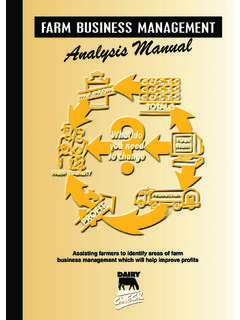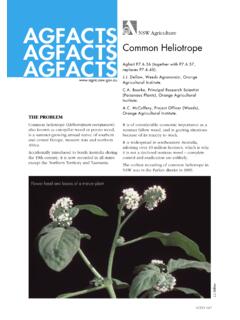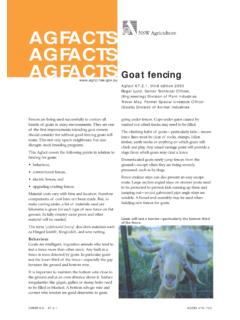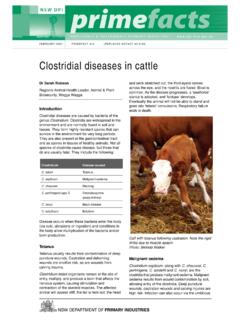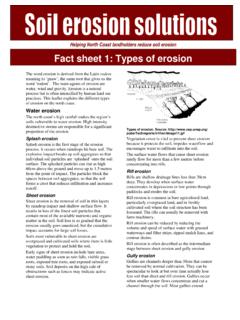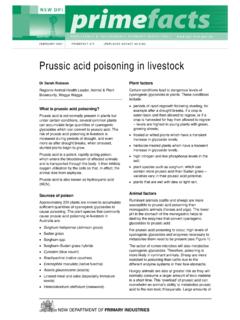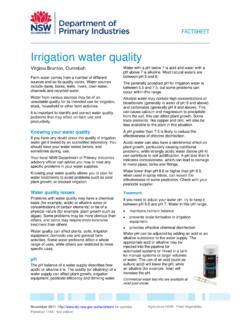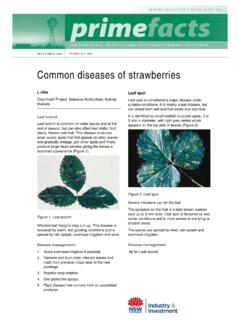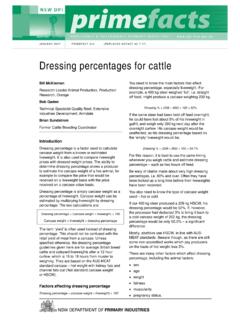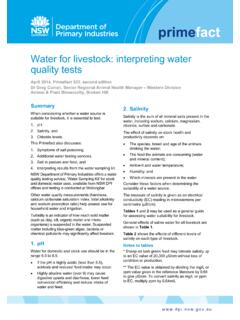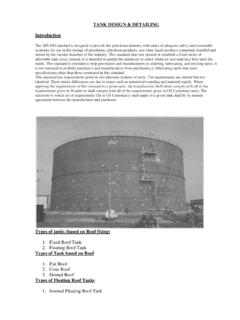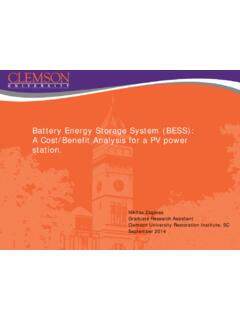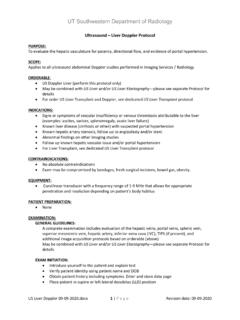Transcription of Blight diseases in mangoes
1 diseases inmangoesThe two main diseases of mangoes areanthracnose and bacterial black spot. This Agnoteexplains the diseases , causes, symptoms and thepesticide program for their is a fungal disease caused byColletotrichum gloeosporioides. It is the most commondisease of mangoes on the north coast of NSW,devastating young leaves and often causingdefoliation of flush growth. If wet weather occursduring flowering, anthracnose causes severeblossom Blight which can destroy inflorescences(flower panicles) and prevent fruit set. Fruit canDPI-489 First edition 2004G. E. Stovold, Plant PathologistJ. F. Dirou, District Horticulturist,NSW Centre for Tropical Horticulture,Alstonvillebe infected up to harvest but visual symptomsusually do not develop until the fruit begins of the fungus are produced from lesionson leaves, dead twigs, mummified inflorescencesand flower sepals.
2 However, the major source ofinoculum for blossom Blight is diseased immatureleaves. On leaves, spores are readily producedover a wide range of environmental conditionsand are dispersed by rain throughout the of flowers depends on the temperatureand duration of surface wetness. Much longerperiods of wetness are required at lowertemperatures (10 13 C) than at highertemperatures (22 25 C).Disease symptomsFlowersBlack and irregular shaped spots grow andcoalesce to cause the death of flower leaf growth is particularly , small, dark spots form and then theycoalesce to form irregularly shaped, dark, drylesions. The dead tissue often cracks and of both anthracnose (left) and bacterial black spot(right) on mango leavesA mango panicle infected with anthracnose disease2 FruitAnthracnose is usually only a problem in fruit thatis ripening, as the fungus remains dormant ingreen fruit during the growing season.
3 Small darkspots form at first and then enlarge rapidly underfavourable conditions. Pink spore masses growon the infected tissue. Such fruit has no can also show a tear-stained patternwhere the infection commences at the stalk-endand runs down the BLACK SPOTB acterial black spot is a bacterial disease causedby Xanthomonas campestris pv. can potentially be more damaging to flowersthan anthracnose. Leaf lesions consist of black,raised, angular areas, restricted by the veins andfrequently surrounded by a yellow stem cankers occur on the bark andcan cause terminal dieback. Fruit lesions consistof individual or multiple star-shaped cracks, oftenappearing with anthracnose lesions in a tearstainpattern.
4 Unlike anthracnose, bacterial lesions donot expand as the fruit disease attacks through natural openingssuch as stomata, wax and oil glands, leaf and fruitabrasions, leaf scars, and at the apex of branchesin the panicle. Damage by adverse environmentalconditions such as frost and wind can also createsites for infection. In young trees the disease cancause dieback of FUNGICIDE SPRAYPROGRAMThe spray recommendations for control ofanthracnose and black spot diseases in NSW areas follows. From panicle emergence to fruit set (earlyAugust to end of October), apply a fungicideregistered for control of anthracnose ( , mancozeb) every two weeks and acopper fungicide registered for control ofbacterial leaf spot every three weeks.
5 Begin thespray program with a copper fungicide. From fruit set until harvest, alternate afungicide registered for control of anthracnosewith a copper fungicide every 14 28 daysdepending on the weather. In dry seasons fewersprays are needed, saving time and flush growth should be sprayed duringautumn. This prevents a build-up of diseaseon young foliage. Azoxystrobin (Amistar WG ), a newstrobilurin fungicide, can be included in thespray schedule to improve control ofanthracnose. Include one or two azoxystrobinapplications at flowering and/or early fruit set,depending on the weather, at no less than 14day intervals and again at 21 and 7 days beforeharvest. Do not apply more than threeapplications per crop, or more than twoconsecutive TREATMENT OFFRUITIt is absolutely necessary for North Coast mangogrowers to use a postharvest treatment beforepacking their fruit to control anthracnose ripe rot.
6 Cold water prochloraz. The breakdown rate ofprochloraz has not been determined so it is onlyapproved as a non-recirculated is not effective against fruit for 30 seconds. A spraying unit canbe made using two TX2 hollow cone nozzlesAnthracnose ripe rot affecting Kensington Pride fruitFruit infected with bacterial black spot. Mango on the left isexuding bacterial above the fruit on the packing operating pressure of 320 kPa delivers 16L per hour. Hot water carbendazim. Submerge fruit for fiveminutes at 52 C. Maintaining the correctdipping temperature is critical to the successof this treatment, so monitor the diptemperature carefully and regularly. Allow 3 Lof dip per kilogram of fruit. Agitate the tankmix to keep the fungicide in suspension andde-sap the fruit before dipping.
7 Carbendazimwill also control stem-end treatments will not providecomplete disease control. It is important to followfield spray recommendations to reduce the levelof postharvest disease, and to cool fruit promptlyfollowing fruit fly treatment is required for theinterstate movement of fruit. Dipping or a floodspray of either dimethoate or fenthion must bethe last treatment applied before PRACTICES AND TREEMANAGEMENTAll commercial varieties have some susceptibilityto anthracnose and bacterial black spot. Siteselection and planting density are important indisease control. Plantings should be located wheresunlight and good air movement will minimisethe duration of leaf wetness following rain, yetstop wind from damaging young shoots, whichpredisposes them to bacterial trees is extremely important.
8 Thisshould be done to remove all sources of inoculumand to maximise air circulation and penetrationof growth should be removed, leavingonly the peripheral foliage. Prune defoliatedbranch terminals and mummified inflorescencesduring the growing season and clip spent fruitstalks during fertiliser sparingly and with caution. Toomuch fertiliser encourages a rapid leaf flush andif this occurs during periods of frequent wetweather trees can become diseased. The best timeto apply fertilisers is immediately followingharvest so that trees produce an autumn INFORMATIONFor further information contact the authors or yourdistrict horticulturist. The State of New South WalesNSW Department of Primary Industries 2004 Edited by Bill NoadCommunications BranchDubbo, September 2004 Agdex 217/10 Job No.
9 4830 DISCLAIMERThe information contained in this publication is based onknowledge and understanding at the time of writing(January 2004). However, because of advances inknowledge, users are reminded of the need to ensurethat information upon which they rely is up to date and tocheck currency of the information with the appropriateofficer of the New South Wales Agriculture or he user sindependent that some of the information in thisdocument is provided by third parties, the State of NewSouth Wales, the author and the publisher take noresponsibility for the accuracy, currency, reliability andcorrectness of any information includedALWAYS READ THE LABELU sers of agricultural (or veterinary) chemical productsmust always read the label and any Permit, before usingthe product, and strictly comply with the directions on thelabel and the conditions of any Permit.
10 Users are notabsolved from compliance with the directions on the labelor the conditions of the permit by reason of any statementmade or omitted to be made in this publication.
